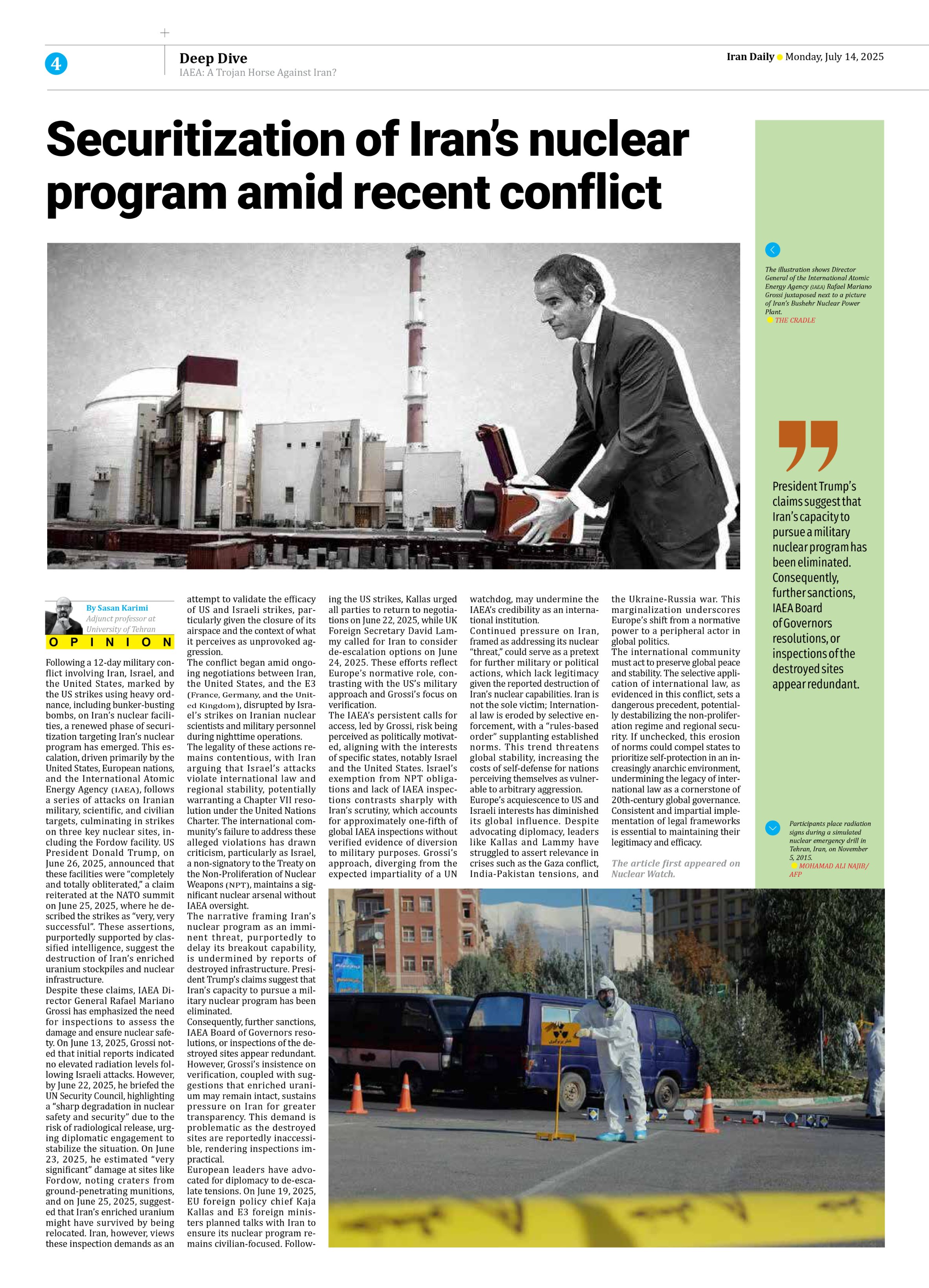Published on Iran Daily, Monday, 14th July 2025

Following a 12-day military conflict involving Iran, Israel, and the United States, marked by the US strikes using heavy ordnance, including bunker-busting bombs, on Iran’s nuclear facilities, a renewed phase of securitization targeting Iran’s nuclear program has emerged. This escalation, driven primarily by the United States, European nations, and the International Atomic Energy Agency (IAEA), follows a series of attacks on Iranian military, scientific, and civilian targets, culminating in strikes on three key nuclear sites, including the Fordow facility. US President Donald Trump, on June 26, 2025, announced that these facilities were “completely and totally obliterated,” a claim reiterated at the NATO summit on June 25, 2025, where he described the strikes as “very, very successful”. These assertions, purportedly supported by classified intelligence, suggest the destruction of Iran’s enriched uranium stockpiles and nuclear infrastructure.
Despite these claims, IAEA Director General Rafael Mariano Grossi has emphasized the need for inspections to assess the damage and ensure nuclear safety. On June 13, 2025, Grossi noted that initial reports indicated no elevated radiation levels following Israeli attacks. However, by June 22, 2025, he briefed the UN Security Council, highlighting a “sharp degradation in nuclear safety and security” due to the risk of radiological release, urging diplomatic engagement to stabilize the situation. On June 23, 2025, he estimated “very significant” damage at sites like Fordow, noting craters from ground-penetrating munitions, and on June 25, 2025, suggested that Iran’s enriched uranium might have survived by being relocated. Iran, however, views these inspection demands as an attempt to validate the efficacy of US and Israeli strikes, particularly given the closure of its airspace and the context of what it perceives as unprovoked aggression.
The conflict began amid ongoing negotiations between Iran, the United States, and the E3 (France, Germany, and the United Kingdom), disrupted by Israel’s strikes on Iranian nuclear scientists and military personnel during nighttime operations.
The legality of these actions remains contentious, with Iran arguing that Israel’s attacks violate international law and regional stability, potentially warranting a Chapter VII resolution under the United Nations Charter. The international community’s failure to address these alleged violations has drawn criticism, particularly as Israel, a non-signatory to the Treaty on the Non-Proliferation of Nuclear Weapons (NPT), maintains a significant nuclear arsenal without IAEA oversight.
The narrative framing Iran’s nuclear program as an imminent threat, purportedly to delay its breakout capability, is undermined by reports of destroyed infrastructure. President Trump’s claims suggest that Iran’s capacity to pursue a military nuclear program has been eliminated.
Consequently, further sanctions, IAEA Board of Governors resolutions, or inspections of the destroyed sites appear redundant. However, Grossi’s insistence on verification, coupled with suggestions that enriched uranium may remain intact, sustains pressure on Iran for greater transparency. This demand is problematic as the destroyed sites are reportedly inaccessible, rendering inspections impractical.
European leaders have advocated for diplomacy to de-escalate tensions. On June 19, 2025, EU foreign policy chief Kaja Kallas and E3 foreign ministers planned talks with Iran to ensure its nuclear program remains civilian-focused. Following the US strikes, Kallas urged all parties to return to negotiations on June 22, 2025, while UK Foreign Secretary David Lammy called for Iran to consider de-escalation options on June 24, 2025. These efforts reflect Europe’s normative role, contrasting with the US’s military approach and Grossi’s focus on verification.
The IAEA’s persistent calls for access, led by Grossi, risk being perceived as politically motivated, aligning with the interests of specific states, notably Israel and the United States. Israel’s exemption from NPT obligations and lack of IAEA inspections contrasts sharply with Iran’s scrutiny, which accounts for approximately one-fifth of global IAEA inspections without verified evidence of diversion to military purposes. Grossi’s approach, diverging from the expected impartiality of a UN watchdog, may undermine the IAEA’s credibility as an international institution.
Continued pressure on Iran, framed as addressing its nuclear “threat,” could serve as a pretext for further military or political actions, which lack legitimacy given the reported destruction of Iran’s nuclear capabilities. Iran is not the sole victim; International law is eroded by selective enforcement, with a “rules-based order” supplanting established norms. This trend threatens global stability, increasing the costs of self-defense for nations perceiving themselves as vulnerable to arbitrary aggression.
Europe’s acquiescence to US and Israeli interests has diminished its global influence. Despite advocating diplomacy, leaders like Kallas and Lammy have struggled to assert relevance in crises such as the Gaza conflict, India-Pakistan tensions, and the Ukraine-Russia war. This marginalization underscores Europe’s shift from a normative power to a peripheral actor in global politics.
The international community must act to preserve global peace and stability. The selective application of international law, as evidenced in this conflict, sets a dangerous precedent, potentially destabilizing the non-proliferation regime and regional security. If unchecked, this erosion of norms could compel states to prioritize self-protection in an increasingly anarchic environment, undermining the legacy of international law as a cornerstone of 20th-century global governance. Consistent and impartial implementation of legal frameworks is essential to maintaining their legitimacy and efficacy.









